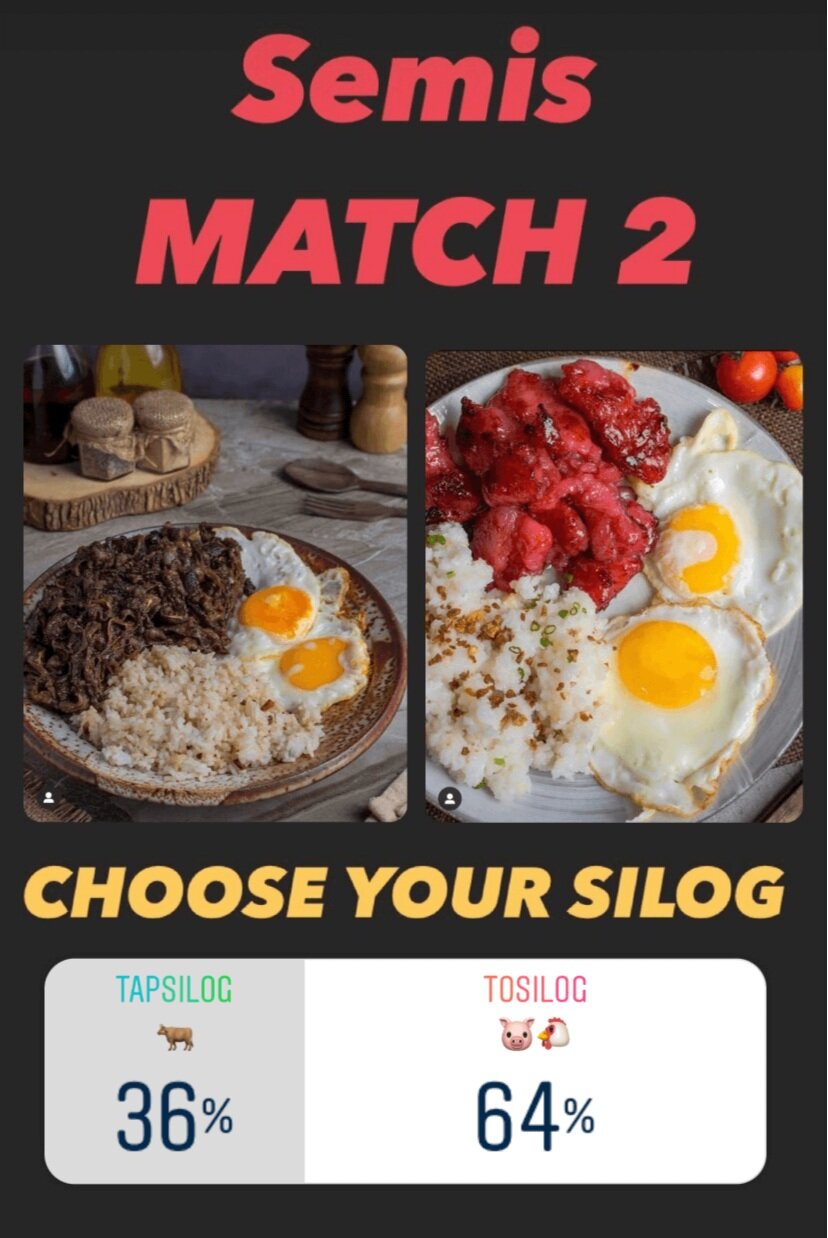Silog Showdown
Filipino Food Crawl hosted a food tournament called Silog Showdown to determine which silog has captured people’s hearts the most. The showdown started off with eight silogs — tapsilog, longsilog, cornsilog, tosilog, dasilog, hotsilog, baconsilog, and spamsilog — and culminated in a neck and neck race for the championship.
Silogs are some of the most loved Filipino dishes. They are simple, easy-to-prepare, and delicious. While this satisfying meal usually marks the beginning of one’s day, it has also become a popular option for lunch, merienda, dinner and even post-drinks recovery.
Throughout the course of the showdown, I received messages of frustration over having a difficult time choosing just one silog. Indeed it’s tough. How can you choose one when you want them all?
Baconsilog and Hotsilog were clearly weak contenders, garnering only 12 and 27 percentage points in their matchups. Dasilog and Spamsilog had the same amount of points but they both succumbed to the more traditional silogs — tapa and tocino. In the semis, Tapsilog vs. Tosilog was hard to call because both are irresistible but alas, pork triumphed over beef. I was hoping for an upset in Cornsilog vs. Longsilog but again, a classic ruled over the modern.
The Finals was clinched by Tosilog by a hair of just five votes. Tosilog took an early lead as the competition started but throughout the course of the day Longsilog evened the score and snatched the lead. As the counting closed however, last ditch efforts from the Tosilog team tipped the polls in their favor.
The Silog Showdown is one of many food tournaments Filipino Food Crawl will host in the coming weeks so make sure to follow on Instagram. The next showdown will either be among pansits or desserts!
Results Recap
A Tikim of a Filipino Breakfast
I love how Doreen Fernandez described the Filipino breakfast in one of the first chapters of Tikim: Essays on Philippine Food and Culture.
Here’s an excerpt (emphasis mine):
“The traditional Filipino breakfast, however, is different from all of the above in that it is not too different from lunch to dinner, and therefore more than a breaker of fasting, being rather a real beginning. Notice that it begins with rice, as all our other meals do. But here, the rice is that left over from the night before, moistened, fried with garlic. This may have started as a time-saver and waste-preventive. Since breakfast can be had as early as 4 a.m., using leftover rice saves someone from getting up at 3 a.m. to cook a fresh pot. If it started as a practical measure, it produced a special treat — sinangag is something to look forward to, rice of a different flavor and aroma, of a special morning goodness.
“With the sinangag comes easy-to-cook accompaniments — daing or tuyo perhaps, fish already dried and salted, ready to the hand, requiring no long preparation. or perhaps tinapa, or the other special kids of salted or preserved fish available through the islands — tiny boneless danggit in Cebu; in Negros binuro, fish buried in rock salt, and cooked with vinegar. My father’s favorite breakfast used to be a plate of rice, scrambled eggs mixed in, binuro broth sprinkled over, and bits of the succulent, salty fish. Or tiny shrimps cooked in garlic or, in some places, coconut milk. Or tapa — pork, beef, venison, wild boar. Or the sweetish tocino; or the longganisas of many persuasions that come in casing or hubad, chunky and flavored with laurel as in Lucban, or spicy in other ways. Eggs may be fried or scrambled, but also salted and sliced, or sautéed with onions and tomatoes. The traditional breakfast foods, however are not necessarily assigned only to breakfasts. Witness the proliferation of tapsi-tapislog places that are open, indeed jammed for lunch, supper, meryenda, and after-hour snacks.”








